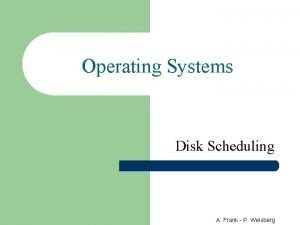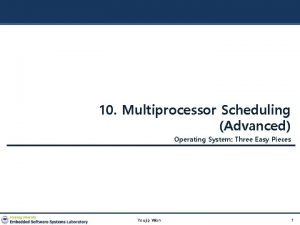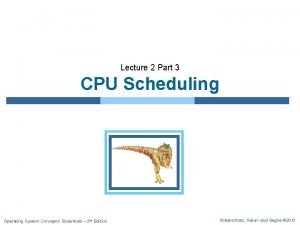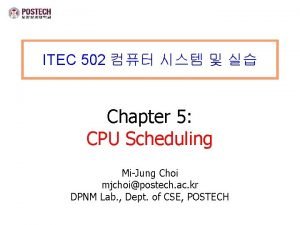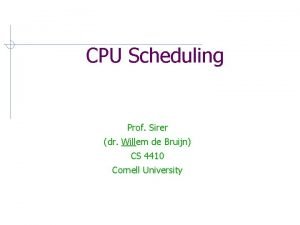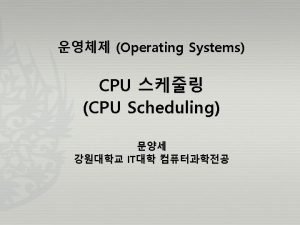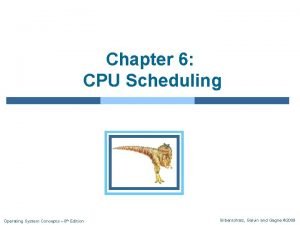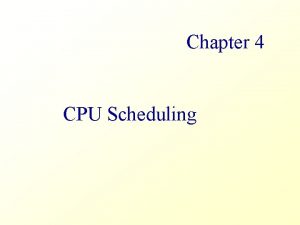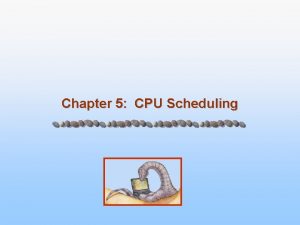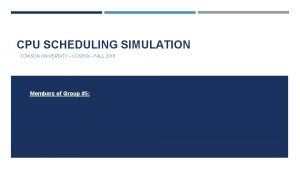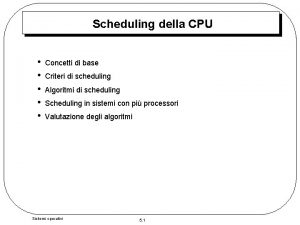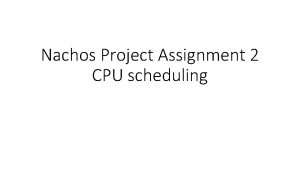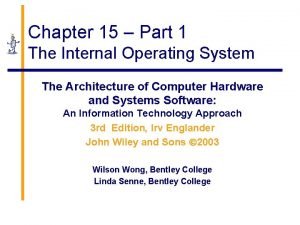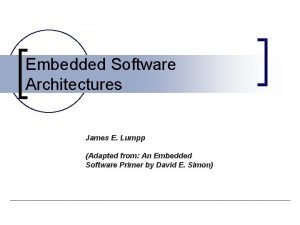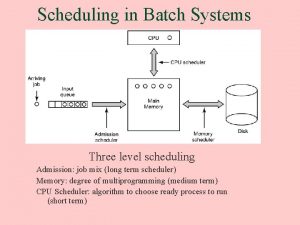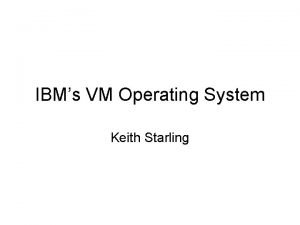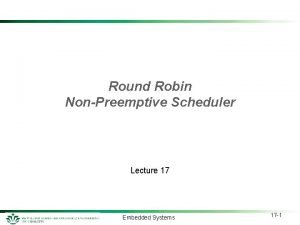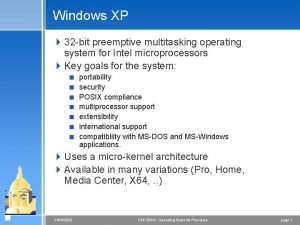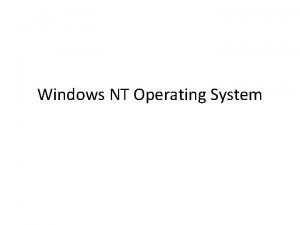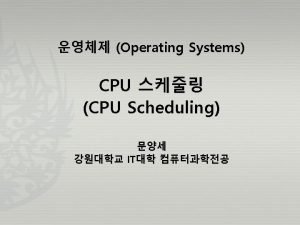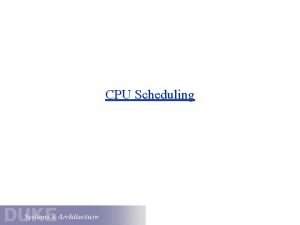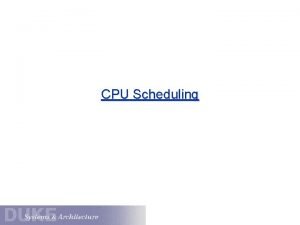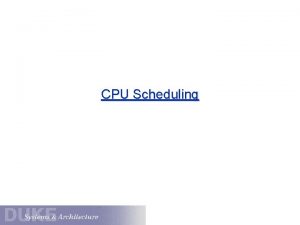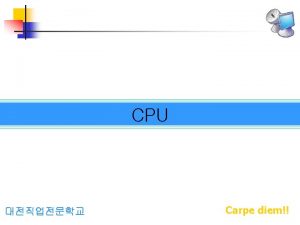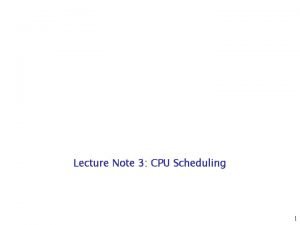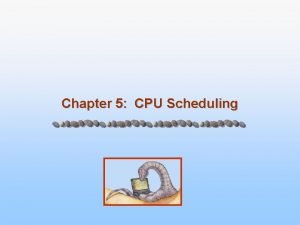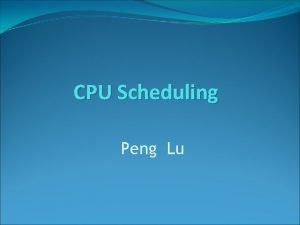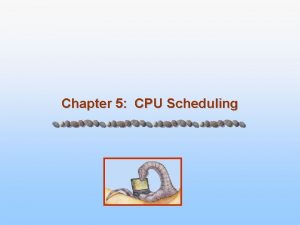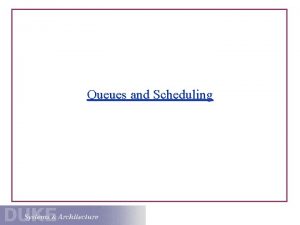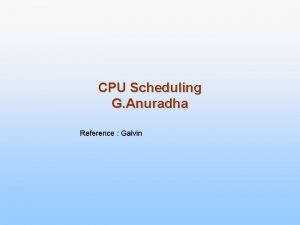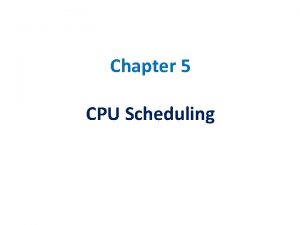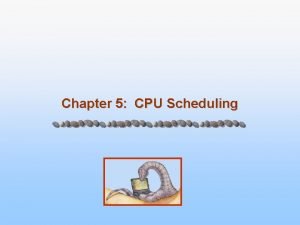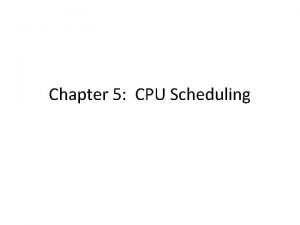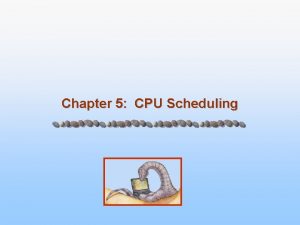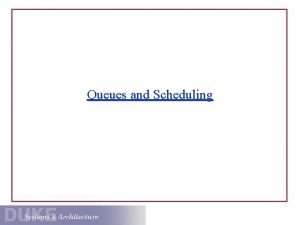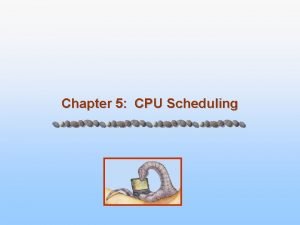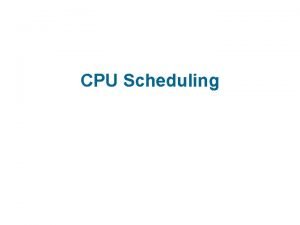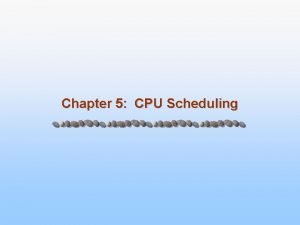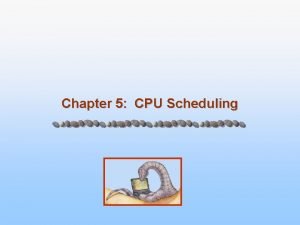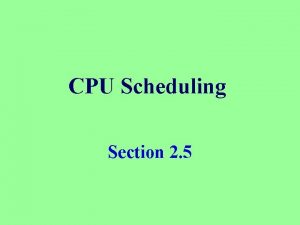Lecture 2 Part 3 CPU Scheduling Operating System








































- Slides: 40

Lecture 2 Part 3 CPU Scheduling Operating System Concepts Essentials – 2 nd Edition Silberschatz, Galvin and Gagne © 2013

Basic Concepts n Maximum CPU utilization obtained with multiprogramming n CPU–I/O Burst Cycle – Process execution consists of a cycle of CPU execution and I/O wait n CPU burst followed by I/O burst n CPU burst distribution is of main concern Operating System Concepts Essentials – 2 nd Edition 3. 2 Silberschatz, Galvin and Gagne © 2013

Histogram of CPU-burst Times Operating System Concepts Essentials – 2 nd Edition 3. 3 Silberschatz, Galvin and Gagne © 2013

CPU Scheduler n Short-term scheduler selects from among the processes in ready queue, and allocates the CPU to one of them l Queue may be ordered in various ways n CPU scheduling decisions may take place when a process: 1. Switches from running to waiting state 2. Switches from running to ready state 3. Switches from waiting to ready 4. Terminates n Scheduling under 1 and 4 is nonpreemptive n All other scheduling is preemptive l Consider access to shared data l Consider preemption while in kernel mode l Consider interrupts occurring during crucial OS activities Operating System Concepts Essentials – 2 nd Edition 3. 4 Silberschatz, Galvin and Gagne © 2013

Dispatcher n Dispatcher module gives control of the CPU to the process selected by the short-term scheduler; this involves: l switching context l switching to user mode l jumping to the proper location in the user program to restart that program n Dispatch latency – time it takes for the dispatcher to stop one process and start another running Operating System Concepts Essentials – 2 nd Edition 3. 5 Silberschatz, Galvin and Gagne © 2013

Scheduling Criteria n CPU utilization – keep the CPU as busy as possible n Throughput – # of processes that complete their execution per time unit n Turnaround time – amount of time to execute a particular process n Waiting time – amount of time a process has been waiting in the ready queue n Response time – amount of time it takes from when a request was submitted until the first response is produced, not output (for time-sharing environment) Operating System Concepts Essentials – 2 nd Edition 3. 6 Silberschatz, Galvin and Gagne © 2013

Scheduling Algorithm Optimization Criteria n Max CPU utilization n Max throughput n Min turnaround time n Min waiting time n Min response time Operating System Concepts Essentials – 2 nd Edition 3. 7 Silberschatz, Galvin and Gagne © 2013

First- Come, First-Served (FCFS) Scheduling Process Burst Time P 1 24 P 2 3 P 3 3 n Suppose that the processes arrive in the order: P 1 , P 2 , P 3 The Gantt Chart for the schedule is: n Waiting time for P 1 = 0; P 2 = 24; P 3 = 27 n Average waiting time: (0 + 24 + 27)/3 = 17 Operating System Concepts Essentials – 2 nd Edition 3. 8 Silberschatz, Galvin and Gagne © 2013

FCFS Scheduling (Cont. ) Suppose that the processes arrive in the order: P 2 , P 3 , P 1 n The Gantt chart for the schedule is: n Waiting time for P 1 = 6; P 2 = 0; P 3 = 3 n Average waiting time: (6 + 0 + 3)/3 = 3 n Much better than previous case Operating System Concepts Essentials – 2 nd Edition 3. 9 Silberschatz, Galvin and Gagne © 2013

Example Operating System Concepts Essentials – 2 nd Edition 3. 10 Silberschatz, Galvin and Gagne © 2013

Shortest-Job-First (SJF) Scheduling n Associate with each process the length of its next CPU burst l Use these lengths to schedule the process with the shortest time n SJF is optimal – gives minimum average waiting time for a given set of processes l The difficulty is knowing the length of the next CPU request Could ask the user Two schemes: – Non-preemptive – once CPU assigned, process not preempted until its CPU burst completes – Can be preemptive – if a new process with CPU burst less than remaining time of current, preempt l • Operating System Concepts Essentials – 2 nd Edition 3. 11 Silberschatz, Galvin and Gagne © 2013

Example of SJF (Non-preemptive) Process. Arrival Time Burst Time P 1 0. 0 6 P 2 2. 0 8 P 3 4. 0 7 P 4 5. 0 3 n SJF scheduling chart n Average waiting time = (3 + 16 + 9 + 0) / 4 = 7 Operating System Concepts Essentials – 2 nd Edition 3. 12 Silberschatz, Galvin and Gagne © 2013

Example of Nonpreemptive SJF Process Arrival Time Burst Time P 1 0. 0 7 P 2 2. 0 4 P 3 4. 0 1 P 4 5. 0 4 P 1 P 3 n SJF 0 3 7 P 2 8 P 4 12 16 n Average waiting time = (0 + 6 + 3 + 7)/4 = 4 Operating System Concepts Essentials – 2 nd Edition 3. 13 Silberschatz, Galvin and Gagne © 2013

Example of Preemptive SJF Process Arrival Time Burst Time P 1 0. 0 7 P 2 2. 0 4 P 3 4. 0 1 P 4 5. 0 4 n SJF (preemptive) P 1 0 P 2 2 P 3 4 P 2 5 P 4 7 P 1 11 16 n Average waiting time = (9 + 1 + 0 +2)/4 = 3 Operating System Concepts Essentials – 2 nd Edition 3. 14 Silberschatz, Galvin and Gagne © 2013

Determining Length of Next CPU Burst n Can only estimate the length – should be similar to the previous one l Then pick process with shortest predicted next CPU burst n Can be done by using the length of previous CPU bursts, using exponential averaging n Commonly, α set to ½ n Preemptive version called shortest-remaining-time-first Operating System Concepts Essentials – 2 nd Edition 3. 15 Silberschatz, Galvin and Gagne © 2013

Prediction of the Length of the Next CPU Burst Operating System Concepts Essentials – 2 nd Edition 3. 16 Silberschatz, Galvin and Gagne © 2013

Examples of Exponential Averaging n =0 n+1 = n l Recent history does not count n =1 l n+1 = tn l Only the actual last CPU burst counts n If we expand the formula, we get: n+1 = tn+(1 - ) tn -1 + … +(1 - )j tn -j + … l +(1 - )n +1 0 n Since both and (1 - ) are less than or equal to 1, each successive term has less weight than its predecessor Operating System Concepts Essentials – 2 nd Edition 3. 17 Silberschatz, Galvin and Gagne © 2013

Example of Shortest-remaining-time-first n Now we add the concepts of varying arrival times and preemption to the analysis Process. Aarri Arrival Time. T Burst Time P 1 0 8 P 2 1 4 P 3 2 9 P 4 3 5 n Preemptive SJF Gantt Chart n Average waiting time = [(10 -1)+(17 -2)+(5 -3)]/4 = 26/4 = 6. 5 msec Operating System Concepts Essentials – 2 nd Edition 3. 18 Silberschatz, Galvin and Gagne © 2013

Example n Draw a Gantt chart that shows the completion times for each process using shortest-job first (preemptive) CPU scheduling and compute the average waiting time? Operating System Concepts Essentials – 2 nd Edition 3. 19 Silberschatz, Galvin and Gagne © 2013

Priority Scheduling n A priority number (integer) is associated with each process n The CPU is allocated to the process with the highest priority (smallest integer highest priority) l Preemptive l Nonpreemptive n SJF is priority scheduling where priority is the inverse of predicted next CPU burst time n Problem Starvation – low priority processes may never execute n Solution Aging – as time progresses increase the priority of the process Operating System Concepts Essentials – 2 nd Edition 3. 20 Silberschatz, Galvin and Gagne © 2013

Example of Priority Scheduling Process. A arri Burst Time. T Priority P 1 10 3 P 2 1 1 P 3 2 4 P 4 1 5 P 5 5 2 n Priority scheduling Gantt Chart P 2 0 1 P 5 P 1 6 P 3 16 P 4 18 19 n Average waiting time = 8. 2 msec Operating System Concepts Essentials – 2 nd Edition 3. 21 Silberschatz, Galvin and Gagne © 2013

Operating System Concepts Essentials – 2 nd Edition 3. 22 Silberschatz, Galvin and Gagne © 2013

Round Robin (RR) n Each process gets a small unit of CPU time (time quantum q), usually 10 -100 milliseconds. After this time has elapsed, the process is preempted and added to the end of the ready queue. n If there are n processes in the ready queue and the time quantum is q, then each process gets 1/n of the CPU time in chunks of at most q time units at once. No process waits more than (n-1)q time units. n Timer interrupts every quantum to schedule next process Operating System Concepts Essentials – 2 nd Edition 3. 23 Silberschatz, Galvin and Gagne © 2013

Example of RR Process Burst Time P 1 24 P 2 3 P 3 3 n Round Robin, quantum=4, no priority-based preemption n The Gantt chart is: Average wait = ((10 -4)+ 4 + 7 )/3 = 5. 7 msec n Typically, higher average turnaround than SJF, but better response Operating System Concepts Essentials – 2 nd Edition 3. 24 Silberschatz, Galvin and Gagne © 2013

Time Quantum and Context Switch Time Operating System Concepts Essentials – 2 nd Edition 3. 25 Silberschatz, Galvin and Gagne © 2013

Turnaround Time Varies With The Time Quantum 80% of CPU bursts should be shorter than q Operating System Concepts Essentials – 2 nd Edition 3. 26 Silberschatz, Galvin and Gagne © 2013

Example of RR with Arrival Time Process Arrival Burst Time P 1 0 P 2 1 P 3 3 n Round Robin, quantum=2 n The Gantt chart is: P 1 0 p 2 2 p 3 4 3 5 4 p 1 6 p 2 7 p 3 9 p 2 11 12 n Average wait = (6 -2) + (2 -1) + (7 -4) +(11 -9) +(4 -3) + (9 -6)= 4. 7 msec Operating System Concepts Essentials – 2 nd Edition 3. 27 Silberschatz, Galvin and Gagne © 2013

Example of RR n Consider the following processes with arrival time and burst time. Calculate average turnaround time, average waiting time and average response time using round robin with time quantum 3? n Solution: Operating System Concepts Essentials – 2 nd Edition Process id P 1 P 2 P 3 P 4 P 5 P 6 Arrival time 5 4 3 1 2 6 3. 28 Burst time 5 6 7 9 2 3 Silberschatz, Galvin and Gagne © 2013

Cont. Process id Arrival time Burst time Completion time Turnaround time Waiting time Response time P 1 5 5 32 27 22 10 P 2 4 6 27 23 17 5 P 3 3 7 33 30 23 3 P 4 1 9 30 29 20 0 P 5 2 2 6 4 2 2 P 6 6 3 21 15 12 12 Average turnaround time= (27+23+30+29+4+15) / 6= 21. 33 Average waiting time= (22+17+23+20+2+12) / 6= 16 Average response time= (10+5+3+0+2+12) / 6= 5. 33 Operating System Concepts Essentials – 2 nd Edition 3. 29 Silberschatz, Galvin and Gagne © 2013

Multilevel Queue n Ready queue is partitioned into separate queues, eg: l foreground (interactive) l background (batch) n Process permanently in a given queue n Each queue has its own scheduling algorithm: l foreground – RR l background – FCFS n Scheduling must be done between the queues: l Fixed priority scheduling; (i. e. , serve all from foreground then from background). Possibility of starvation. l Time slice – each queue gets a certain amount of CPU time which it can schedule amongst its processes; i. e. , 80% to foreground in RR l 20% to background in FCFS Operating System Concepts Essentials – 2 nd Edition 3. 30 Silberschatz, Galvin and Gagne © 2013

Multilevel Queue Scheduling Operating System Concepts Essentials – 2 nd Edition 3. 31 Silberschatz, Galvin and Gagne © 2013

Multilevel Feedback Queue n A process can move between the various queues; aging can be implemented this way n Multilevel-feedback-queue scheduler defined by the following parameters: l number of queues l scheduling algorithms for each queue l method used to determine when to upgrade a process l method used to determine when to demote a process l method used to determine which queue a process will enter when that process needs service Operating System Concepts Essentials – 2 nd Edition 3. 32 Silberschatz, Galvin and Gagne © 2013

Example of Multilevel Feedback Queue n Three queues: l Q 0 – RR with time quantum 8 milliseconds l Q 1 – RR time quantum 16 milliseconds l Q 2 – FCFS n Scheduling l l A new job enters queue Q 0 which is served FCFS 4 When it gains CPU, job receives 8 milliseconds 4 If it does not finish in 8 milliseconds, job is moved to queue Q 1 At Q 1 job is again served FCFS and receives 16 additional milliseconds 4 If it still does not complete, it is preempted and moved to queue Q 2 Operating System Concepts Essentials – 2 nd Edition 3. 33 Silberschatz, Galvin and Gagne © 2013

Algorithm Evaluation n How to select CPU-scheduling algorithm for an OS? n Determine criteria, then evaluate algorithms n Deterministic modeling l Type of analytic evaluation l Takes a particular predetermined workload and defines the performance of each algorithm for that workload n Consider 5 processes arriving at time 0: Operating System Concepts Essentials – 2 nd Edition 3. 34 Silberschatz, Galvin and Gagne © 2013

Deterministic Evaluation n For each algorithm, calculate minimum average waiting time n Simple and fast, but requires exact numbers for input, applies only to those inputs l FCS is 28 ms: l Non-preemptive SFJ is 13 ms: l RR is 23 ms: Operating System Concepts Essentials – 2 nd Edition 3. 35 Silberschatz, Galvin and Gagne © 2013

Queueing Models n Describes the arrival of processes, and CPU and I/O bursts probabilistically l Commonly exponential, and described by mean l Computes average throughput, utilization, waiting time, etc n Computer system described as network of servers, each with queue of waiting processes l Knowing arrival rates and service rates l Computes utilization, average queue length, average wait time, etc Operating System Concepts Essentials – 2 nd Edition 3. 36 Silberschatz, Galvin and Gagne © 2013

Little’s Formula n n = average queue length n W = average waiting time in queue n λ = average arrival rate into queue n Little’s law – in steady state, processes leaving queue must equal processes arriving, thus: n=λx. W l Valid for any scheduling algorithm and arrival distribution n For example, if on average 7 processes arrive per second, and normally 14 processes in queue, then average wait time per process = 2 seconds Operating System Concepts Essentials – 2 nd Edition 3. 37 Silberschatz, Galvin and Gagne © 2013

Simulations n Queueing models limited n Simulations more accurate l Programmed model of computer system l Clock is a variable l Gather statistics indicating algorithm performance l Data to drive simulation gathered via 4 Random number generator according to probabilities 4 Distributions 4 Trace defined mathematically or empirically tapes record sequences of real events in real systems Operating System Concepts Essentials – 2 nd Edition 3. 38 Silberschatz, Galvin and Gagne © 2013

Evaluation of CPU Schedulers by Simulation Operating System Concepts Essentials – 2 nd Edition 3. 39 Silberschatz, Galvin and Gagne © 2013

End of Chapter 6 Operating System Concepts Essentials – 2 nd Edition Silberschatz, Galvin and Gagne © 2013
 What is disk scheduling in os
What is disk scheduling in os Mqms
Mqms Turnaround time in os
Turnaround time in os Preemptive priority scheduling
Preemptive priority scheduling Sjf cpu scheduling
Sjf cpu scheduling Fcfs calculator
Fcfs calculator Sjf cpu scheduling
Sjf cpu scheduling Sjf cpu scheduling
Sjf cpu scheduling Scheduling concepts
Scheduling concepts A cpu scheduling algorithm determines an order
A cpu scheduling algorithm determines an order Cpu scheduling project
Cpu scheduling project Scheduling della cpu
Scheduling della cpu Cpu scheduling project
Cpu scheduling project Operating system lecture notes
Operating system lecture notes Sjn scheduling
Sjn scheduling 01:640:244 lecture notes - lecture 15: plat, idah, farad
01:640:244 lecture notes - lecture 15: plat, idah, farad The internal part of an operating system.
The internal part of an operating system. Buddy system example
Buddy system example File system in operating system
File system in operating system Ufs4.0
Ufs4.0 File system in operating system
File system in operating system What is algorithm goals of batch systems?
What is algorithm goals of batch systems? Round robin architecture in embedded system
Round robin architecture in embedded system Scheduling in batch system
Scheduling in batch system Keith starling
Keith starling Round robin scheduling in embedded system
Round robin scheduling in embedded system Part part whole addition
Part part whole addition Part to part ratio definition
Part to part ratio definition Brainpop ratios
Brainpop ratios What is a technical description
What is a technical description Parts of a bar counter
Parts of a bar counter The phase of the moon you see depends on ______.
The phase of the moon you see depends on ______. Two way anova minitab 17
Two way anova minitab 17 Power system dynamics and stability lecture notes
Power system dynamics and stability lecture notes Zline 667-36
Zline 667-36 Healthmis.ng
Healthmis.ng Lymphatic system lecture
Lymphatic system lecture Power system dynamics and stability lecture notes
Power system dynamics and stability lecture notes Windows preemptive multitasking
Windows preemptive multitasking Integral subsystem
Integral subsystem What is operating system definition
What is operating system definition
